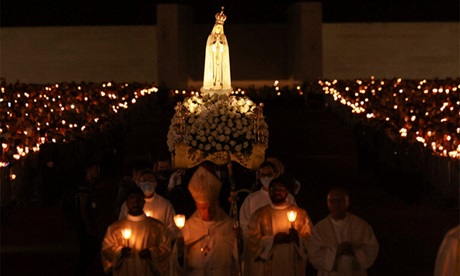In a society fascinated by the supernatural, it is important to focus on authentic faith rather than being swayed by extraordinary signs and wonders.
So says Joachim Bouflet, a historian and specialist in mystical phenomena.
“The mystical search is not noisy; it plays out in the most intimate places. We do not need to accumulate signs to believe; the Gospel should suffice,” Bouflet told La Croix’s Christophe Henning in an interview.
Bouflet’s known for his extensive research on religious mystics and supernatural events.
The interview
La Croix : The text [the Vatican document on Marian apparitions], comes from the Dicastery for the Doctrine of the Faith: what does this mean?
Joachim Bouflet: In a society sensitive to the marvelous and the supernatural, it is an opportunity to invite people to distance themselves from these phenomena.
“It is important to remember that signs, whatever they may be, do not change our faith. This should lead to greater rigour in the face of such propositions.
“For example, why turn to the pseudo-mystic Maria Valtorta (1897-1961), when the Church does not recognise her writings as being of supernatural inspiration?
“Especially when there are so many authentic and recognised mystics, such as John of the Cross, Edith Stein, and Madeleine Delbrêl.
La Croix : Isn’t it primarily the apparitions of the Virgin that are at the heart of this debate?
Joachim Bouflet: The apparitions of the Virgin nourish the imagination, but do they nourish faith? I am not certain.
“When pilgrims go to Rue du Bac in Paris, whether the Virgin appeared or not does not change their prayer to Mary.
“Do they even know that there has been no official recognition of the apparitions to Catherine Labouré [1806 – 1876, French member of the Daughters of Charity of Saint Vincent de Paul]?”
What’s the attraction?
La Croix : How do you explain the enthusiasm for these signs that could support the Christian faith?
Joachim Bouflet: Because there is a thirst for novelty: why do people overlook Padre Pio, who experienced many strange phenomena? Today, he is canonised and attracts less interest.
“Who is interested in Sister Mariam of Jesus Crucified, a Carmelite who died at the age of 32 in Bethlehem, in 1878?
“For many of our contemporaries, more than a mystical search, it seems to me to be an escape from reality, a way to reassure themselves with exaggerated devotions. As if we needed the extraordinary, denigrating a simple faith.
“Yet, the mystical search is not noisy; it plays out in the most intimate places. We do not need to accumulate signs to believe; the Gospel should suffice.”
Faith
La Croix: Faith is incarnate; it is charity, concern for the poor, work for peace. Faith is at work; it does not need extraordinary signs.
If the apparitions themselves may not be essential, what significance can pilgrimages still have?
Joachim Bouflet: In Lourdes or Pellevoisin, for example, and in many other places of Marian prayer, there is a true pastoral ministry around Mary, whether there was an apparition or not.
Popular piety comes to pray to the Virgin and expects no other help. I trust in popular faith.
On the other hand, some use the supernatural to provoke emotion, sensationalism, escalation, which has nothing to do with faith.
Faith is incarnate; it is charity, concern for the poor, work for peace.
Faith is at work; it does not need extraordinary signs.
- First published in La Croix
- Christophe Henning is a journalist at La Croix International
Additional reading
News category: Analysis and Comment.




